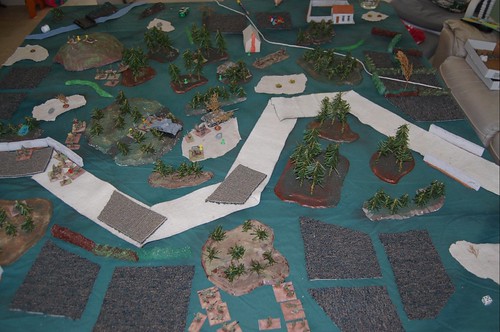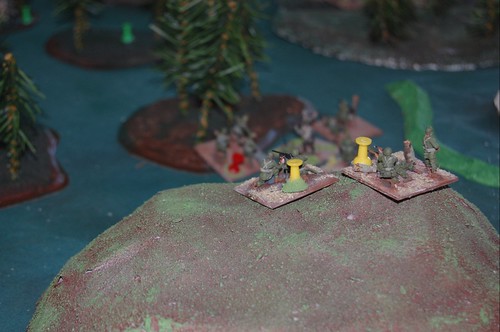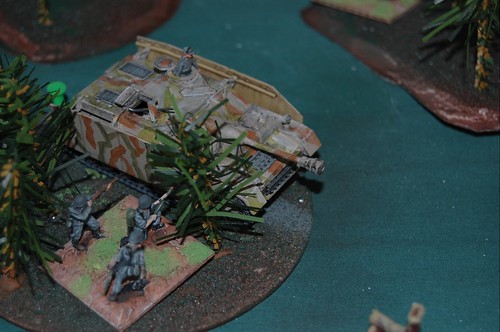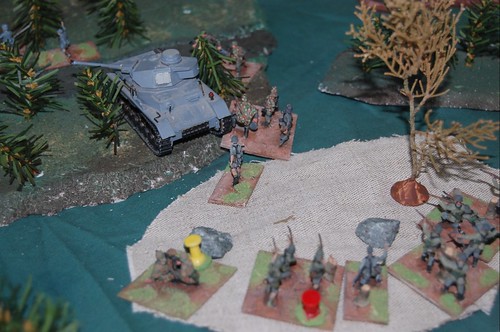This was the second game we were assigned to play in the World Crossfire Day campaign. It was set up for 4 players, one of whom was to be the umpire. Taking advantage of the umpire, the scenario has some secret objectives and events.
When we played it, I overemphasized getting off the table, when the scenario was written more for them to stay and fight it out for a while. While the Allies have the surprise of finding Germans in the woods, once the discovery has been made, it would be in the interest of the game to encourage them to take advantage of the situation and attack swiftly.
| Allied Forces | German Forces |
|---|---|
2 American regular leg infantry companies
1 CC (+0)
1 HMG
1 FOO 81mm mortar and 12FMs
3 Platoons with:
PC (+1*), 3 rifle stands (1 with bazooka)
A British signals officer
* Rallying only
|
1st Coy: (regular) CC (+1) 1 HMG FOO for 81mm mortar with 10FMs 1 Panzerschreck PC (+2), 3 rifle stands PC (+1), 3 rifle stands PC (+1), 3 rifle stands 2nd Coy (regular) CC (+1) 1 HMG FOO with 10FMs 81mm mortar PC (+1), 3 rifle stands PC (+0), 2 rifle stands Pioneer platoon (green) : PC (+1) 3 rifle stands, also lots of picks and shovels 1 Panzer IV 1 StuG IV 1 Jagdpanzer IV |
ObjectivesAdvance across the board on your way to your objective, which is three miles off-table to the north. Exit the northern edge. N.B: the Americans are not expecting to encounter enemy here, and the mortars are travelling with the unit. When hostilities start, they will fall back to off-table and start setting up, which will take some time. The mortars will be ready for action at 1640GT. |
BriefingThree AFVs were coming through your area of the front when some allied aeroplanes flew over. The AFVs swerved off the road and into a wood in the centre of your table, and there they got bogged down. Some have since become unbogged and have driven away, but three remain: a Stug IV, a Jagdpanzer IV, and a Pz IV. These will be placed by the umpire, who will bear in mind that they were trying to escape to the north when they swerved off-road to find cover (so broadly facing N, but possibly a bit E or W but not S). The deployment of your troops will depend on what information they have received. This will depend on what happened at a certain telegraph office in game #7A. The two possibilities are:
You will be told on the day which state your men are in. Your main priority is to hold the front long enough for the three AFVs to get unbogged. One problem is that the more men you devote to defending the front, the fewer are helping to dig out the stricken tanks. Tough choice. Once the tanks are away, you are free to pull back if things look grim, and get away off the north edge of the table, however killing allies is always good for the war effort, so if things are still looking fine, stay put and keep shooting. |
Special rules:
- Vehicles: unlimited movement but could only fire their main gun once per initiative. Additional MG fire was possible, but only used 3 dice.
- Un-Bogging: tanks required 6 Un-Bogging Points to get free. The referee rolled for these in secret. Starting with 2 dice, each squad assisting added 1 die (max 3), a PC would add 1, and a towing tank could add 2 more to a maximum of 8 possible dice. Each six rolled added 1 UBP to the total. If a 1 was rolled and no 5's or 6's were rolled, then 1 UBP was subtracted from the total.
- Typhoons: Appeared at a given time in the game and attacked any tank in the open. If there were no tanks, then it would attack any visible infantry stands (friendly fire on a roll of 1).
Setup
The terrain is countryside, especially woods, and quite dense, especially in the central region of the table. The allied entry side is the south, heading north. Running N-S across the table, about a quarter of the way in from the eastern edge, is a winding road. Running from the centre of the W side of the table to the centre of the N edge, is a length of black cotton. The umpire does not draw attention to this.
The German forces deployed hidden and were place by the referee.
The Allies entered the table from the northern edge..
Umpire Notes
The Americans are expecting no resistance. If they fail to see the opportunity to destroy three valuable enemy assets, they fail. Let them walk off the north edge and leave the AFVs alone if they really want. If the message of their approach has not got through, then the first they see of the Germans will be a lot of turned backs. If they are clever, they will deploy thoroughly before opening fire, because once initiative swaps for the first time, the Germans will doubtless deploy PDQ. Give no clues that these hidden troops are unaware of the Americans. Players always assume that hidden troops = waiting-in-ambush-troops, well this scenario may be an exception. You can report the sounds of men shouting to each other in German and roaring engines. Do not tell the Americans that the vehicles are bogged. Let them work it out for themselves.
AFV Firing
When bogged, the turretless vehicles have a fire arc of just 22 degrees total. Only the PzIV can fire in all directions. However, it cannot manoeuvre for a good shot, so only does 3d6 with its turret (it also has to be careful of not injuring nearby infantry working on it).
Unbogging a tank
This depends on how many men are trying to help. The referee makes the rolls, and gives some hints to the German player as to how well he is doing.
Each tank needs a total of 6 DBP (DeBogging Points, of course) to get moving for the first time (if it gets stuck again, 2 DBPs will shift it).
A tank rolls 2d6 to unbog plus 1 extra die per stand of infantry helping it (max three stands), and another for an officer of +1 calibre or better helping. If the German player hits on the idea of using one tank to tow another, add two more dice. Every result of 6 gains 1 DBP. The maximum would therefore be 2 (tank) +3 (infantry stands) +1 (officer) +2 (towing vehicle) = 8 dice.
Every result of 1 on the dice ADDS one to the number of DBPs that must be gained before a tank can unbog UNLESS any of the other dice rolled shows a 5 or 6. This means that rolling few dice at a time will take especially long, because on average with 2d6, for every 2 DBP you score, you'll add one to the number you need.
These rolls do not risk the initiative, but only one roll may be made per initiative.
Once free, a tank may move again, but every action it takes off-road requires a 1d6 roll, and a result of 1 means a bog. Note that an attempt to tow another vehicle is a move action.
Signaler
If the figure of the signaler crosses the length of cotton thread, roll 1d6. On a result of 4+ he recognizes it for what it is — field telephone cable. If the American player deliberately places the signaler on the thread and asks him to investigate it, there is no need to roll the die. The signaler can report this, and can clip his field telephone in and have a listen. If he does, he will hear lots of military chatter in German, some of it sounding quite urgent, to judge by the tone of voice.
Clock
The game starts at 1630 GT. At the end of every allied initiative, roll 1d6 and advance the clock 5 minutes on a result of 4+.
The US mortars will be ready for action at 1640GT.
At 1740GT, two Typhoons fly overhead. The umpire adjudicates the effect. They will not see any tanks in the dense centre section of the table, nor in any overhead cover like woodland. Any tank visible from the air will get eight rockets fired at it by the first Typhoon, and, if it is a solitary AFV and survives, eight from the next. These rockets were 4-inch things, and the whole lot being fired was equivalent to a broadside from a cruiser. Against soft vehicles they were devastating. Against AFVs they had little effect unless they scored a direct hit, in which case the vehicle generally bought it. Roll a die, on a 5 or 6, the vehicle is destroyed. If no tanks are visible, roll to see if any troops can be spotted and identified. On a 4+, some Germans visible from the air will be strafed with gunfire: roll four dice, regardless of cover. Repeat for the second aircraft. If a 1 is rolled for the observation, an attacking stand of friendly troops is misidentified and strafed.
House rules:
A bazooka gets +1 ACC if in the same terrain feature as the target. Bazookas hit on 2+ at close combat range.
Bogged vehicles are -2 in close combat.
The Game
We played this scenario on April 4, 2009, starting at 2:00 PM and ending at 5:05 PM. Two players ran a company each on the allies side and the third player was the Germans. Because of events early in the day, the Germans were deployed by the Umpire around the tanks in the middle of the table. Most of the platoons were hidden, except for the engineers. I'm not sure if that's how the scenario was intended, but it's how I understood it that day.
1630 GT
The allies started the game by moving on to the table. They brought a couple platoons on first and maneuvered to where they had LOS to the Panzer IV. Then they decided to try a bazooka attack, but it missed and they lost the initiative. The Germans spent most of their force digging out the AFVs and only had one platoon engage the Allies.
1640 GT
Eventually the Allies got the initiative back and determined that it was more important to reach their off-table destination. So the decision was made to bypass the German force in the woods as much as possible and continue on north. Soon two of the US Platoons had left the north edge of the board.
Meanwhile the roar of an engine could be heard in the woods as the engineers freed the Jagdpanzer from the mud. Since there wasn't an armored threat, the local commander decided it would be more useful helping pull out the Panzer IV — since that one was making the least progress.
On the west flank, the a US platoon with HMG support was engaging the German squads that had emerged from the woods. The firefight continued steadily without either side making much progress. The Company Commander even got involved to call in a mortar attack (when they were ready) but the Germans remained stubbornly entrenched.
Finally there was movement on the German side as a fresh platoon entered the fray (I think it was one working on the Jagdpanzer earlier). It turned out to be a bad move because at that point the US squads decided to get serious about the firefight. Even though they were pinned on the hill, the American HMG and rifle squad wiped out the German counter-attack. First by rolling three sixes to kill one squad and then a series of suppressions that eliminated the others.
1705 GT
Meanwhile the engineers working on the StuG managed to get it released and and it roared out of the woods, turned north on the road and left the table.
On the other side, the US platoons were making their way around the woods and found the land line. They called in the British Signaler to investigate and he discovered that it was a telephone line and listened in. Unfortunately the German player did not realize that he should have worked to prevent this and so the Allies got some free points out of it.
1715 GT
On the west flank another US platoon left the table. In the center the second US company started calling down mortar fire on the exposed engineers around the Panzer IV.
1740 GT
While the firefights were dying down a flight of Typhoons came overhead. The Jagdpanzer was the only vehicle in the open and became the first target. It managed to survive the first pass, but the second Typhoon destroyed it.
1745 GT
The Panzer IV was finally freed and didn't waste time hanging around. It too escaped off north edge.
1750 GT
With the armor gone (and time running out), the Germans decided to pull their forces back and soon left board.
Losses
German: 1st company lost 3 rifle and a PC. 2nd company lost 3 rifle, a PC, and a HMG.
US: lost 1 HMG from 2nd company.






